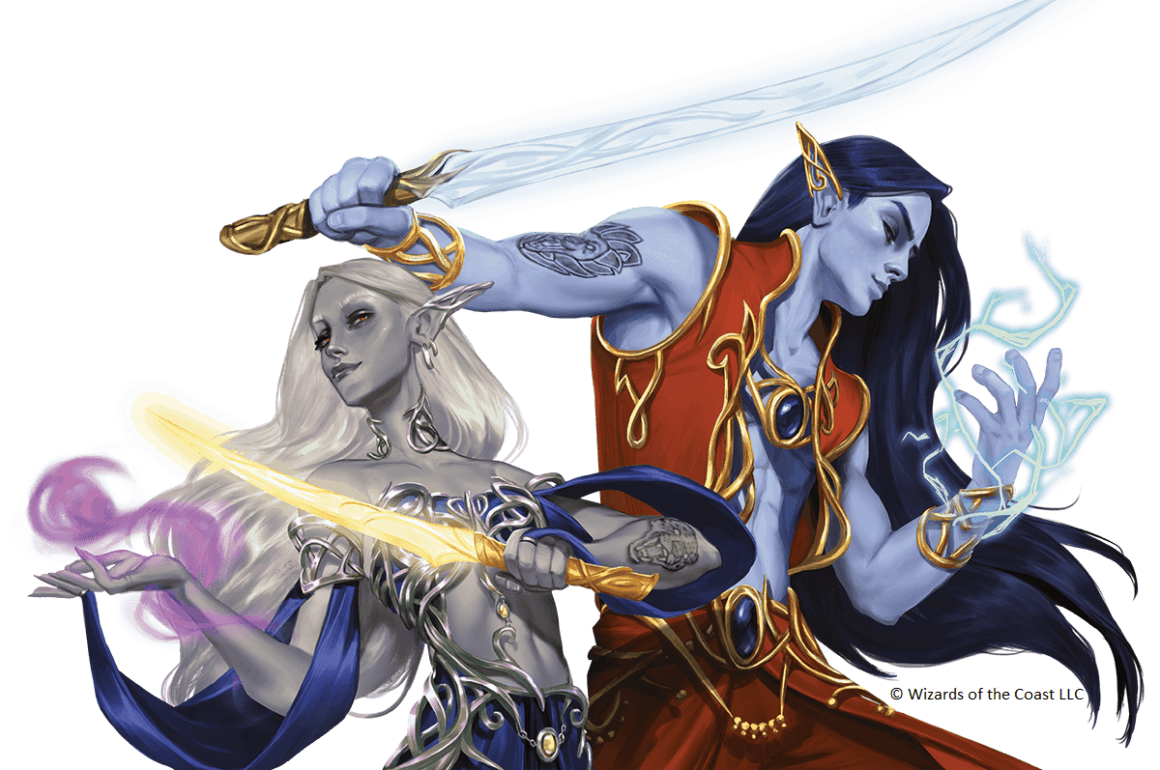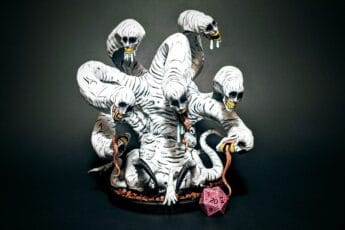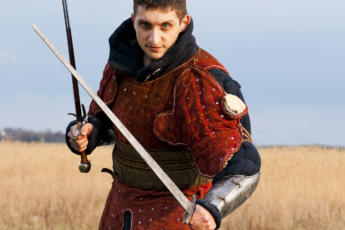
There’s something iconic about a character in D&D rushing into battle wielding a sword and spells simultaneously. Cutting down an enemy and then throwing a fireball just seems like one of the best things ever.
If this is something that appeals to you as a player, you’re in luck. Enter the Bladesinger 5E. But how does the Bladesinger work? What are the best races, feats, spells, etc.? This complete guide to the Bladesinger will answer all your questions and more.
What is the Bladesinger?
The Bladesinger first appeared in second edition D&D. It is a wizard and fighter hybrid that can both sling spells as well as swords. Having both martial and magical powers available to you make for a much more interesting and diverse character. The most recent iteration of the class can be found in Tasha’s Cauldron of Everything on page 76.
Advantages of Bladesingers
One of the advantages of Bladesingers is their versatility. Most of the time in D&D, you are either a martial class that focuses on physical attacks or a spellcasting class that focuses on spells for damage and effects.
However, the Bladesinger has the best of both worlds. Since you are not multiclassing, you will have access to all the best wizard spells by staying in the wizard class the entire time. Through the Bladesinger option, you gain abilities such as light armor proficiency and extra attack, thus making you a formidable fighter as well.
Disadvantage of Bladesingers
Though the Bladesinger is undoubtedly a fun class to play, it is not the most powerful. Usually, Wizards only have to focus on raising one ability score, their intelligence. However, the Bladesinger must raise both intelligence and dexterity. Also, as you become higher level and are granted access to more powerful spells, most of the time you will find your spells would be more effective than your weapon.
Armor class will also be an issue. Though you are granted light armor proficiency through “Training in War and Song,” allowing you to raise your armor class a little, your AC will not be particularly strong enough at higher levels to avoid being hit. That brings us to another issue; hit points.
Hit points are a big problem for Bladesingers. Coming in at 1D6, which is the lowest in D&D 5E, it is no surprise that Wizards are a bit squishy. This is usually not a problem because they are very rarely found in combat. However, Bladesingers seek out combat and thus require more hitpoints.
Pop culture references
There are a few pop culture references that come to mind when thinking of a Bladesinger. The most recent is Vilgefortz from The Witcher on Netflix, Geralt of Rivia, more in the video games than the series so far, and of course, the OG of the Bladesingers, Gandalf with his sword Glamdring.


Best Races for a Bladesinger
Though the Bladesinger’s race used to be limited to elf or half-elf, with the new rules introduced in Tasha’s Cauldron of Everything, the racial requirement has been removed, allowing any race to become a Bladesinger if they wish. But which race is the best choice?
When looking at the best race for your Bladesinger, or any class really, you want to decide which ability scores are most important to you and try to find a race that increases those. For the Bladesinger, it will be intelligence and dexterity.
Here’s a brief list of a few races, in no particular order, that are ideal based on their ability score modifiers.
| Race | INT Bonus | DEX Bonus | WIS Bonus | Speed |
| Forest Gnome | +2 | +1 | NA | 25ft |
| Deep Gnome | +2 | +1 | NA | 25ft |
| High Elf | +1 | +2 | NA | 30ft |
| Wood Elf | NA | +2 | +1 | 35ft |
| Variant Human | +1 | +1 | NA | 30ft |
Forest Gnome & Deep Gnome
Gnomes are not traditionally what I think of when I imagine a Bladesinger, but their ability modifiers are perfect, specifically forest gnomes and deep gnomes. With a +2 to intelligence and a +1 to dexterity, you would have the ideal start to a Bladesinger.
Forest Gnomes also get Mirror Illusion which is always helpful. Their biggest downside is their movement of 25ft which will limit their mobility in getting in and out of combat.
High Elf
Elves created the Bladesingers, so of course, they would be a good choice. High elves, in particular, stand out because of their +1 intelligence and the traditional +2 dexterity awarded to all elves. High elves also gain a free cantrip, which never hurts. There really is no downside to a high elf Bladesinger. They are the perfect way to start your character.
Wood Elf
Wood elves with their +2 to dexterity are a good way to go if you want to focus more on the sword fighting aspects of the Bladesinger. Their speed is also 35ft which means they will be able to move in and out of combat a little quicker than the high elf, variant human, or gnome. Unfortunately, their +1 to wisdom does nothing for a Bladesinger build.
Variant Human
The truth is, variant humans are a good choice for any class. The capability to put your points in whatever ability you wish is a huge advantage. They are a great choice for the Bladesinger, not just because of the aforementioned ability placement but also the bonus feat. Wizards do not get very many feats, and this is an excellent opportunity to get one at first level.
Background
Background is one of those things that depends entirely on the character you are playing. I would focus mainly on role-playing for these choices rather than optimal character building.
Maybe you’re a former soldier who realized he had magic, thus becoming a Bladesinger. Or perhaps you’re a hermit that has always wanted to dance, and it wasn’t until you met an elven Bladesinger in the woods that you finally ventured out to show the world your sick moves.
As you can see, background is up to how you want to role-play your character. If you’re still having trouble deciding which one will work for you, here is a list of a few good ones for Bladesingers.
| Background | Skill Proficiency | Tool Proficiency | Extra Language |
| Acolyte | Insight (WIS) Religion (INT) | None | Any 2 |
| Sage | Arcana (INT) History (INT) | None | Any 2 |
| Noble | History (INT) Persuasion (CHA) | Gaming Set | Any 1 |
| Cloistered Scholar | History (INT) Choose one Arcane (INT) Nature (WIS) or Religion (INT) | None | Any 2 |
Ability Scores
Ability scores are critical when creating a character, especially a Bladesinger. Most of the time, when building a wizard, you want to put your highest score in intelligence, and the rest doesn’t matter too much since Wizards tend to stay out of combat.
However, Bladesingers seek out combat, so you wind up arranging your ability scores a little differently. In this article, we are assuming you are using the point buy system. However, if you are rolling for your ability scores or using standard array, we will break that down, too.
Ability Scores in Order of Importance
# 1 – Intelligence
Like with all Wizards, the most crucial ability score for you will be intelligence. This should be where you put most of your points, highest score, or your highest roll. Intelligence is your spellcasting ability for your wizard spells. It is what determines your spell save DCs and spell attack modifiers.
# 2 – Dexterity
Coming in at #2 is dexterity. Because your Bladesinger should be using light finesse weapons, your dexterity will both count towards your weapon attacks and damage as well as your armor class, making dexterity a double whammy that you should put your next highest score in.
# 3 – Constitution
Constitution is not something traditional Wizards are usually concerned with, but since Bladesingers will be in combat more often, it is rather important. One of the biggest problems with Bladesingers is their lack of hit points, so having a higher constitution will help mitigate that.
# 4 – Wisdom
When it comes to making a Bladesinger, wisdom is not very important. It is at #4 because, in my experience, you are more likely to roll wisdom saves for spells than strength or charisma. Also, wisdom perception checks may be one of the most predominant in D&D 5E, so it’s good to at least have a 10 or above in this ability.
# 5 & 6 Strength – Charisma
Strength and charisma are basically interchangeable when it comes to the Bladesinger. When making this choice, I would go with characterization. Put the higher score in whichever represents your character better. If your character was a former soldier, put it in strength. If your character is a street performer, put it in charisma.
If you want a more technical answer, in my opinion, strength/athletics checks are more common than most charisma-based checks. So, if you’re worried about optimizing every part of your character, I would go strength.
Here is how I would arrange ability scores for a Bladesinger using point buy (27 points), standard array, or rolled ability scores.
| Abilities | Point Buy 27 Points | Standard Array | Rolled Scores |
| Strength | 8 | 10 | 10 |
| Dexterity | 15 | 14 | 15 |
| Constitution | 14 | 13 | 13 |
| Intelligence | 15 | 15 | 17 |
| Wisdom | 10 | 12 | 11 |
| Charisma | 8 | 8 | 9 |

Feats
Here is a list of feats that are good for the Bladesinger. However, unless you are taking a feat at first level for being a variant human, I recommend raising your intelligence and dexterity to at least 18, if not 20, before taking any feats.
Raising your intelligence will increase your spell attacks and your spell saves, while raising your dexterity will increase your armor class as well as your weapon attacks and damage.
Here is a list of feats you should consider for your Bladesinger.
Mobile
Mobile is a good choice for somebody who plans to spend most of their time in melee combat. Adding an extra 10 feet to your movement and allowing you to move out of combat without an attack opportunity makes your character uniquely portable.
Spell Sniper
Spell Sniper is great at increasing the range of your spell attacks which is always advantageous. Add in an extra cantrip, and being able to ignore half cover and three-quarters cover, and Spell Sniper is a no-brainer.
War Caster
War Caster is fantastic for spellcasters that will be in combat, like the Bladesinger. Having advantage on concentration saving throws to maintain your spells is excellent. Being able to perform the somatic component of spells without needing a free hand opens dual wielding and other fun aspects, like sword and wand dual wielding. Being able to use a spell for an opportunity attack could change the course of a battle. War Caster is a worthwhile feat for Bladesingers.
Bladesinger 5E Build by level: 1 – 20.
Here’s a brief layout, from level 1 to 20, of how I would build a Bladesinger.
Level 1
Features – Spellcasting, Arcane Recovery
Cantrips – Booming Blade, Mirror Illusion, Firebolt, High elf bonus cantrip: Green Flame Blade
Spells – Shield, Find Familiar, Mage Armor, Magic Missile, Thunder Wave, Expeditious Retreat
Level 2
Features – Arcane Tradition: Bladesinger – Training in War and Sword, Bladesong
Cantrips – None
Spells – Burning Hands, Absorb Elements
Level 3
Features – None
Cantrips – None
Spells – Misty Step, Minor Image
Level 4
Features – Ability Score Improvement: +2 to INT or DEX (Max 20)
Cantrips – Green Flame Blade, if you don’t already have it, or Sword Burst
Spells – Blur, Scorching Ray
Level 5
Features – None
Cantrips – None
Spells – Haste, Fireball
Level 6
Features – Arcane Tradition, Bladesinger – Extra Attack
Cantrips – None
Spells – Counterspell, Hypnotic Pattern
Level 7
Features – None
Cantrips – None
Spells – Banishment, Greater Invisibility
Level 8
Features – Ability Score Improvement: +2 to INT or DEX (Max 20)
Cantrips – None
Spells – Arcane Eye, Dimension door
Level 9
Features – None
Cantrips – None
Spells – Cold Monster, Steel Wind Strike
Level 10
Features – Arcane Tradition, Bladesinger – Song of Defense
Cantrips – Mending
Spells – Wall of Force, Rary’s Telepathic Bond
Level 11
Features – None
Cantrips – None
Spells – Chain Lightning, Contingency
Level 12
Features – Ability Score Improvement: +2 to INT or DEX (Max 20)
Cantrips – None
Spells – Disintegrate, Mass Suggestion
Level 13
Features – None
Cantrips – None
Spells – Plane Shift, Simulacrum
Level 14
Features – Arcane Tradition, Bladesinger – Song of Victory
Cantrips – None
Spells – Forcecage, Teleport
Level 15
Features – None
Cantrips – None
Spells – Clone, Maze
Level 16
Features – Ability Score Improvement: +2 to INT or DEX (Max 20)
Cantrips – None
Spells – Feeblemind, Sunburst
Level 17
Features – None
Cantrips – None
Spells – Wish
Level 18
Features – Spell Mastery – Shield, Misty Step
Cantrips – None
Spells – Hold Monster
Level 19
Features – Ability Score Improvement: +2 to INT or DEX (Max 20)
Cantrips – None
Spells – Chain Lightning
Level 20
Features – Signature spells – Counterspell, Haste
Cantrips – None
Spells – None

Role Playing Your Bladesinger
Trying to write a role-playing section is always hard because, ultimately, you should play the character that you want to play. Make it fun, funny, or dramatic. If it’s what you want to do, do it! Here’s an example of something I came up with while writing this article.
Herbert is a high elf whose father is one of the most renowned fighters in the land, and his mother is one of the best wizards. His father trained him in sword fighting in hopes that he would follow in his footsteps, but his mother insisted he go to college. His father thought this was a good idea. If sword fighting didn’t work out, he could fall back on his education.
While at the wizard college, he took an extracurricular in dance and fell in love. After telling his parents that he just wanted to be a dancer, they laughed and told him there was no future in it and forced him to finish college.
Now saddled with a tremendous amount of debt from his wizard college days, he sets forth to find his fortune, or mainly to just make his student loans payment. Ultimately combining all of his skills, sword fighting, spell casting, and dance, to develop his very own unique style, he became the first Bladesinger.
Final Thoughts
Bladesinger is a unique and fun class to play in D&D 5E. The best part of the class is its versatility, allowing you to dabble in melee combat as well as spellcasting. Really, the only downside to the class is at higher levels. They will have a serious problem with their hit points, but if you keep this in mind, and maybe play with hit and run tactics, you shouldn’t have any issues.
I hope this article helped you understand more of the Bladesinger, and I can’t wait to see what you guys come up with.
There is no right or wrong; there is only your imagination.
Now get out there and play!





I’d also argue that Jadis, the White Witch from the Chronicles of Narnia, makes an excellent example of the bladesinger, especially from the battle scene in The Lion, the Witch, and Wardrobe where she is dual-wielding her petrifying wand and a sword, counterspelling a phoenix-conjured wall of fire, and the like.
Martin, what an awesome point. Don’t know how I forgot about Narnia. Thanks for reading and commenting. You’re actually my first comment ever on this site!
Thanks for this build. I usually struggle on my own as a beginner. This is awesome!!
Ellie! Thank you so much for reading, I’m glad that it helped you out. And welcome to D&D!